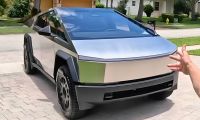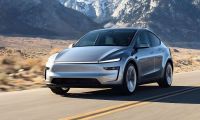Porsche made waves earlier this year when their Taycan Turbo set the Nürburgring (Nordschleife) lap record for a four-door production electric vehicle; however, the Taycan set a slightly less publicized – but arguably more significant – track record just a few days earlier.
With the help of trackside DC fast chargers, the Taycan was able to travel 2,128 miles in 24 hours on the Nardo test center track. This translates into an average travel speed of over 88 mph including time spent stopped while recharging. Because of legal speed limits, traffic, weather, and other factors, the Taycan’s average trip speed on Nardo won't translate directly to daily driving, but it is far more relevant to the average person than the Taycan's 7:42 lap time on Nürburgring.
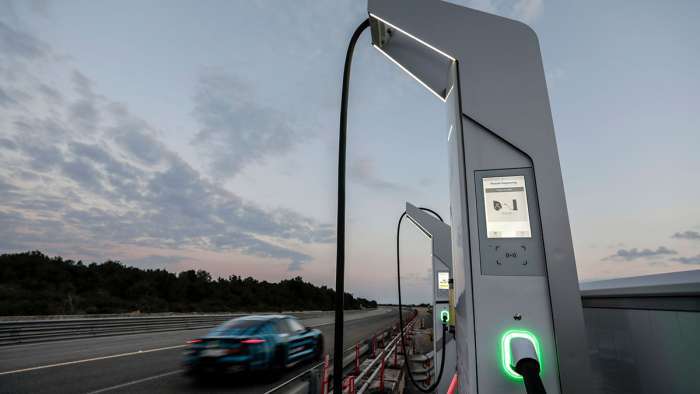
Even though most people rarely drive farther in a day than the 200-mile range of most modern electric vehicles, one of the most frequent criticisms of electric vehicles is their inability to travel long distances in a similar time as an internal combustion car. This is due primarily to the amount of time it takes to recharge an electric car while traveling. It appears, however, that Porsche has overcome that barrier with the Taycan.
In this story, I will discuss the current EV cannonball record across the United States, and I explain just how fast the Porsche Taycan could do the same run in the hands of an experienced electric vehicle driver (or two drivers in the case of a cannonball run). Further, I will illustrate the fact that the infrastructure required for the Porsche Taycan to achieve these cannonball run times is already in place.
Cannonball Runs Are Illegal
First, let’s get this part out of the way. Cannonball runs in their truest form are illegal. Internal combustion cars can make the trip across the United States in around 24 hours, but if you consider the average driving speed required for that time, the drivers are exceeding the legal speed limit by a very large margin. In fact, they are driving so fast that, if they were caught, the driver could face jail time.
In recent news, a team set a new record for crossing the country in a heavily modified Mercedes with a 65-gallon gas tank. They only made three fueling stops totaling 22 minutes of time stopped. A typical gas stop can require 5 to 10 minutes of “slop” time just exiting the freeway, getting to the pump, and getting back on the road, so limiting their fueling stops represented a huge time savings for that cannonball run team. However, the biggest time savings came from the fact that they averaged 103 mph driving speed, which is 20 miles faster than the fastest posted speed limit in the United States.
Based on the Porsche Taycan’s travelling 2,128 miles in 24 hours and the trip across the United States typically being just over 2,825 miles, the Taycan should be able to drive across America in just over 32 hours. However, in practice, the legal speed limit will be the biggest factor in determining how fast a Porsche Taycan can drive across the United States. Driving excessive speeds not only introduces an issue of legality, for electric vehicles, high speeds quickly reach a point of diminishing returns. Fueling stops themselves take time away from driving, so for best trip times, it’s necessary to balance efficiency and speed to minimize the number of stops and maximize the time spent charging.
When keeping to within 10% of the legal speed limit (the upper limit of what most drivers would find acceptable), the average trip speeds slow down considerably. So while the Porsche Taycan won’t be able to replicate its 88 mph average trip speed from Nardo in the real world, it could still easily best the current EV cannonball held by a Tesla Model 3.
Current EV Cannonball Record Held By Tesla Model 3
So far, Tesla and their owners have been the only ones to really focus on cross-country cannonball runs, with several Tesla Model 3 driving teams crossing the United States in between 45 and 50 hours. The current record is 45 hours and 16 minutes, which again was only achievable by exceeding speed laws.
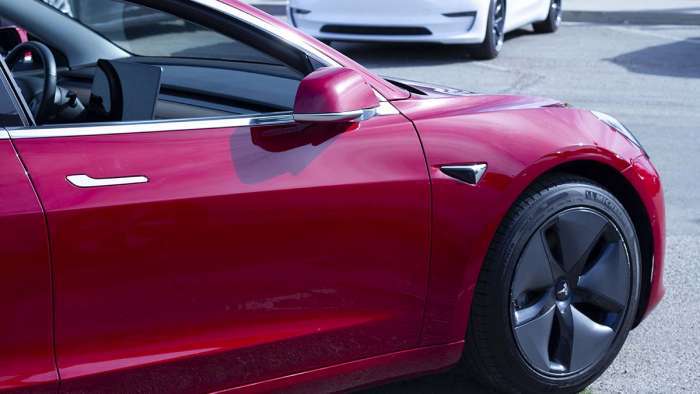
These records were set using a Tesla Model 3 Long Range rear wheel drive (the fastest trip car in Tesla's lineup) while using Tesla’s existing Supercharger Network, and the current record represents an average trip speed of just over 62 mph, which is well within the Porsche Taycan’s theoretical 88 mph average trip speed.
Until now, no other electric vehicles could approach the trip speeds the Tesla Model 3 is capable of, but the Taycan is different. Without question, it could shatter the existing EV cannonball record across the United States, and here’s why.
The Porsche Taycan Charges Faster
Electrify America recently published a release about the Porsche Taycan using one of their 350 kW CCS chargers to charge from 5% to 80% battery in only 22.5 minutes. That’s more than 5 minutes faster than a Tesla Model 3 would take to charge to the same level on Tesla's newest, fastest 250 kW “V3” Superchargers.
Many Tesla owners and media sites have tried to explain away the Porsche Taycan’s charging speed while claiming that the Tesla Model 3 still actually charges faster. Essentially, the argument is that because they question whether Porsche Taycan’s range is similar to the Tesla Model 3’s range, an 80% battery in the Taycan represents fewer miles than 80% battery in the Model 3, and the difference in actual range added more than compensates for the Taycan’s faster charging rate. This argument is flawed for a number of reasons. Partly, that is due to a disconnect resulting from using different metrics, but the other factor is simply a refusal to accept how efficient the Taycan is just how fast it actually charges.
While most automakers measure the charging speed based on the actual power level (e.g., 270 kW peak for the Porsche Taycan), Tesla takes a different approach. They measure charging speed based on estimated range added per hour. Tesla’s metric allows for some funny math because it is based on EPA ranges which many Tesla models struggle to achieve in real-world driving, and a cannonball run would be even more taxing.
Ben Sullins (host of Teslanomics) charged his own Tesla Model 3 to full (a rated range of 310 miles), and under normal driving conditions, he was only able to achieve 281 miles before the battery died. Porsche recently gave Ben the opportunity to spend 10 hours with a Taycan, and during his testing, Ben drove the Taycan from Marina Del Rey to Wrightwood (a 6,000 foot elevation gain) and then back to the Electrify America charging station in Burbank, which I reviewed on my channel. Despite those driving conditions – including acceleration and performance testing up to 100 mph – Ben noted that the Taycan would have seen 270 miles of range on that drive.
Essentially, we already have a real-world proof that the Porsche Taycan's range is very similar to the Tesla Model 3, but there is some science to back this up further.
The Porsche Taycan is More Aerodynamic than the Tesla Model 3
The Tesla Model 3 is, in its own right, a highly aerodynamic vehicle, which is one of the primary reasons for its range and efficiency. However, the Porsche Taycan's aerodynamic profile is jaw dropping. While Model 3's coefficient of drag (Cd) is .23, the Taycan’s is even lower at .22 Cd. What is more, the Taycan actually has a smaller frontal area. The Porsche Taycan's coefficient of drag area (CdA) is only 5.52 versus the Tesla Model 3's 6.98 CdA. That represents a 20% less drag in the Porsche Taycan.
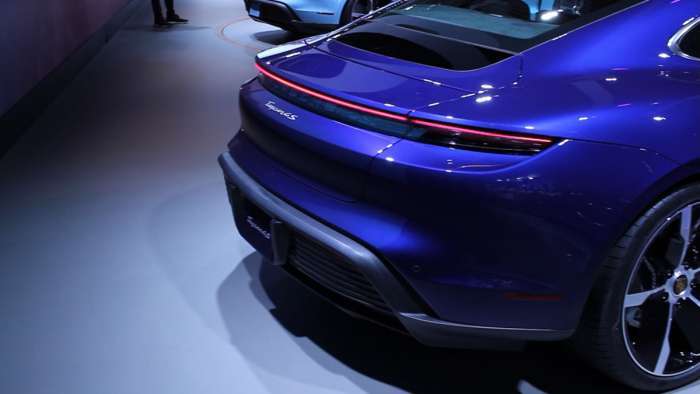
The reason these numbers matter is that, at freeway speeds, the energy required to overcome drag can exceed 80% of the total energy consumed by the car. So while it might be true that the lighter Model 3 with its narrower, low rolling resistance tires is far more efficient than the Taycan when accelerating or driving around town, all of those advantages are lost with high-speed, long-distance travel like a cannonball run.
The 20% aerodynamic drag advantage that the Taycan enjoys means that, regardless of what the different range rating systems such as EPA and WLTP might say, the best the Model 3 can hope for is to match the Taycan's efficiency at 75 to 85 mph, but even that is unlikely. As weather conditions worsen (e.g., cold weather or wind), the Taycan’s advantages grow.
Even if we assume that the Porsche Taycan and Tesla Model 3 are evenly matched at this point (which they probably are), there’s another essential aspect of the cannonball run that must be considered. The infrastructure needs to be in place to support those fastest driving speeds.
The Porsche Taycan Can Access a Better Charging Network for Cannonball Runs
This might catch some people by surprise because the EV media loath to discuss how rapidly the public charging infrastructure is growing; however, the Porsche Taycan actually has access to a better network for cannonball runs across the United States than the Tesla Model 3. In the last year and a half, Electrify America alone has built over 350 charging sites, and most of those sites have at least two of their fastest 350 kW CCS chargers. What is more, many of those sites are located in 100 mile intervals just off of major interstates across most of the country.
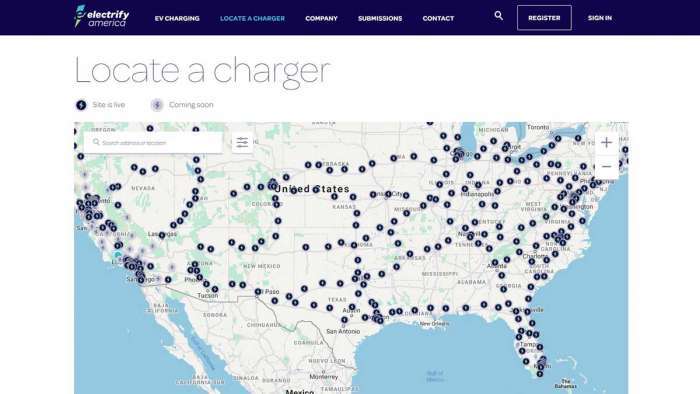
While Tesla's Supercharger network is well-dispersed and designed for cross-country travel, it is relatively old and slow by modern charging standards. Tesla is now rolling out their fastest 250 kW V3 Superchargers (most of those have been limited to California), and most of their network for crossing the country is still using Tesla's shared 120 kW to 150 kW charging architecture. The Porsche Taycan, on the other hand, has access to hundreds of 350 kW CCS charging sites scattered along interstates across the entire country.
To illustrate the difference, Bjorn Nyland – Norway's resident electric vehicle expert – even prioritizes these 350 kW CCS charging stations provided by the Ionity Network over Tesla's European Superchargers when he is driving his Tesla Model 3 (in Europe, the Tesla Model 3 comes equipped with the CCS-2 standard) because the public 350 kW CCS chargers actually charge at a faster rate than V2 Superchargers. In the case of the Porsche Taycan, the difference in charging speed is even greater because its 800 V architecture enables it to charge 50% faster than a Tesla Model 3 using the same charging unit.
Now it is true that there are still some gaps in Electrify America's network; however, most of those gaps are easily traversed by an electric vehicle with well over 200 miles of freeway range and 80% battery. What is more, in several cases where the gaps are too far even for a 200-mile EV, the rest of the public charging infrastructure is backing up Electrify America. The best example is the 200-mile gap between Southern California and Las Vegas, where a Porsche Taycan owner would also have the opportunity to charge at a 350 kW EVgo charger in Baker, California. The Taycan wouldn't lose a step.
The main takeaway here is that the Porsche Taycan has access to consistently faster charging sites while crossing the country than a Tesla Model 3. Tesla is just now starting to distribute their V3 Superchargers, so it will likely be a year or more before Tesla's faster charging infrastructure has caught up with Electrify America's initial build out of 350 kW charging stations.
In the meantime, we can estimate just how fast the Porsche Taycan could cross the United States.
Porsche Taycan Across the United States
For me, it's not really a question of whether the Porsche Taycan is the fastest electric vehicle in terms of crossing the United States; the only question right now is exactly how long a cannonball run across the United States would take in a Taycan. Based on my initial projections, the trip should take about 44 hours while still driving reasonably. Essentially, the Taycan could break the current EV cannonball run record without breaking a sweat.
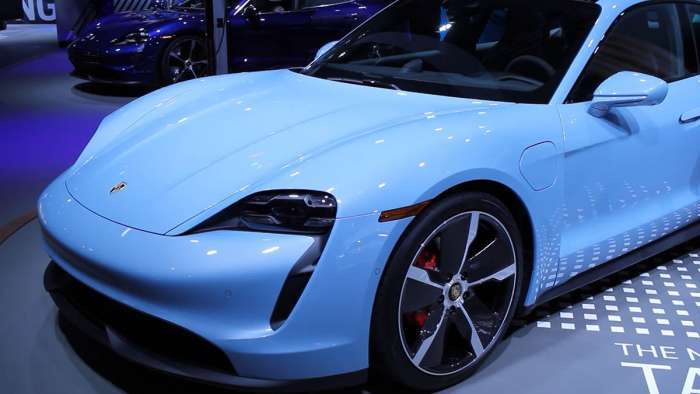
Here are my assumptions based on two drivers, staying within 10% of the posted speed limit, and not encountering significant delays due to traffic, road construction, or weather. Also, note that I've only listed public charging sites with 350 kW CCS charging capability.
Portofino Hotel > Baker, CA (197 miles; 25 min charge)
Baker, CA > Mesquite, AZ (171 miles; 10 minute charge)
Mesquite, AZ > Cedar City, UT (92 miles; 10 minute charge)
Cedar City, UT > Richfield, UT (114 miles; 35 minute charge)
Richfield, UT > Junction City, CO (225 miles; 10 minute charge)
Junction City, CO > Glenwood Springs, CO (88 miles; 15 minute charge)
Glenwood Springs, CO > Frisco, CO (91 miles; 15 minute charge)
Frisco, CO > Fort Morgan, CO (149 miles; 20 minute charge)
Fort Morgan, CO > North Platte, NE (181 miles; 15 minute charge)
North Platte, NE > Grand Island, NE (136 miles; 20 minute charge)
Grand Island, NE > Council Bluffs, IA (147 miles; 15 minute charge)
Council Bluffs, IA > Waukee, IA (117 miles; 10 minute charge)
Waukee, IA > Williamsburg, IA (102 miles; 10 minute charge)
Williamsburg, IA > Geneseo, IL (107 miles; 10 minute charge)
Geneseo, IL > Joliet, IL (113 miles; 10 minute charge)
Joliet, IL > Mishawaka, IN (112 miles; 10 minute charge)
Mishawaka, IN > West Unity, OH (101 miles; 15 minute charge)
West Unity, OH > Sheffield Lake, OH (128 miles; 20 minute charge)
Sheffield Lake, OH > Clarion, PA (159 miles; 25 minute charge)
Clarion, PA > Bloomsburg, PA (176 miles; 20 minute charge)
Bloomsburg, PA > Red Ball Garage, NYC (148 miles)
This is just an initial estimate that could be adjusted and improved with a little more planning and time behind the wheel of the Taycan, but it represents 41 hours of driving at the posted speed limit or 37 hours if driving 10% over the posted speed limit (77 mph average driving speed). Based on these initial estimates, the Taycan would require about 19 charging stops to make the trip, and I typically allot about 5 minutes per stop of "slop time" (the time taken to get to and from the charger) which totals about 1 hour 30 minutes. The total charging time would be about 5 hours 30 minutes.
So my conservative total trip time estimate for the Porsche Taycan to cross the country would be under 48 hours while maintaining the speed limit or just over 44 hours if driving 10% over the posted speed limit. Even if restricted to driving at a reasonable speed, the Porsche Taycan's cannonball time to cross the United States would be slightly faster than the fastest EV cannonball run to date. However, if driving just 10% over the posted speed limit, the Porsche Tacyan could beat the EV cannonball run record by over an hour.
If Porsche would like me to demonstrate this, all I ask is that they hand me and a codriver the keys to a fully charged Porsche Taycan on the West Coast on a Friday evening and book us a flight back from New York City to Southern California on Sunday night. I’m a simple man, and I have to work on Monday.
Eric Way focuses on reporting expert opinion on GM brand electric vehicles at Torque News. Eric is also an instructional designer and technical writer with more than 15 years of writing experience. He also hosts the News Coulomb video blog, which focuses on electric vehicles, charging infrastructure, and renewable energy. Eric is an active member of the EV Advocates of Ventura County, a volunteer organization focused on increasing the widespread adoption of electric vehicles. You can follow Eric on News Coulomb Youtube, on Facebook at @NewsCoulomb as well as on Twitter at @eway1978.








